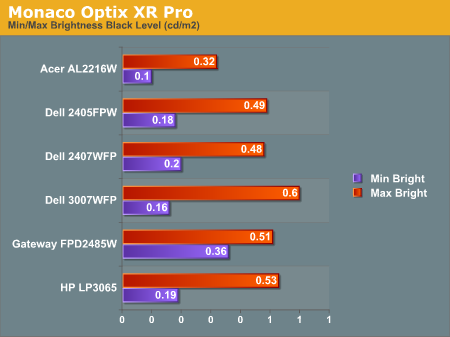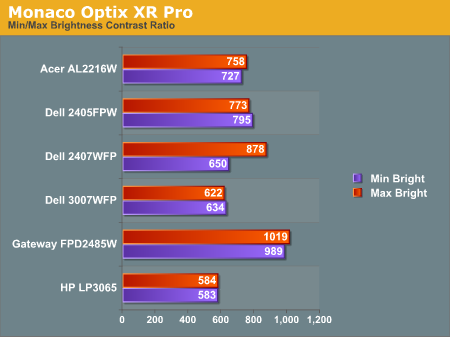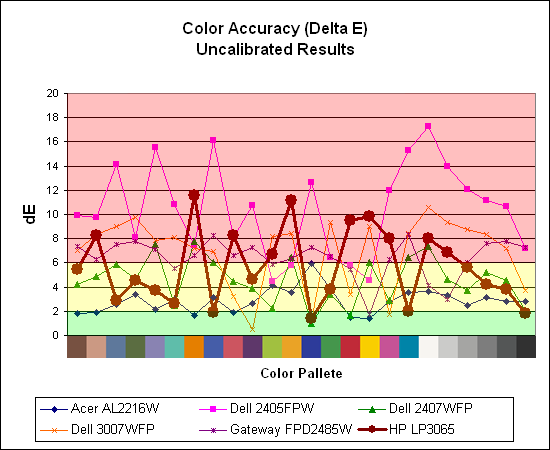HP LP3065: A new contender for the 30" throne
by Jarred Walton on March 22, 2007 7:00 AM EST- Posted in
- Displays
Uncalibrated Results
Brightness and Contrast Ratio
For these tests more than any others, we depend on the hardware colorimeter and software to help calibrate the displays. As previously stated, we use a Monaco Optix XR (DTP-94) colorimeter and Monaco Optix XR Pro software. The software and hardware are relatively easy to use and help users to get more accurate color from their displays. Before we get to the calibrated results, we took a quick look at how the displays performed at maximum brightness as well as how they fared without any color profile. We used the default contrast and color settings for all the displays, with the brightness level adjusted according to various "easy calibration" charts.



All three of the Dell LCDs are relatively consistent in terms of brightness levels and contrast ratios. The Gateway FPD2485W on the other hand is clearly brighter than the other LCDs, and it also has a higher contrast ratio. It's interesting to note that the HP LP3065 actually doesn't have as bright of a backlight as the older Dell 3007WFP, and in fact the 3007WFPHC also lists a slightly lower maximum brightness. The HP display also has a lower contrast ratio - the "worst" of the bunch in fact. As we mentioned in the Gateway review, however, looking at these numbers really doesn't tell you a whole lot about how a display really performs. In the case of the Gateway LCD, even at minimum brightness it can feel overly bright in some environments.
Color Accuracy
The problem with calibrating a display is that it doesn't help all applications. Specifically, the video overlay used when watching DVDs or other movies completely bypasses any color profiles, so you are essentially stuck with the uncalibrated colors. It is possible to tweak things slightly on some LCDs using the OSD, but the amount of color correction that can be done via the OSD pales in comparison to color correction tables, and LCDs like the Dell 3007WFP and HP LP3065 are unable to adjust anything but brightness outside of software. Ideally, we would like to see video drivers begin to apply color profiles to the overlay output as well, but we're not sure how much work that would require - or if it's even possible.
For uncalibrated color accuracy, we adjusted the brightness and contrast (where applicable) using a "calibrate by eye" chart. Also remember that color accuracy can vary from penalty panel even within the same model, and the results we are reporting are only from looking at a single LCD. We ended up using 91% brightness (nine steps down from maximum brightness) on the HP LCD.
During testing, Monaco Optix XR Pro sends 24 color patches to the display with the colorimeter measuring the resulting values. The difference between what is requested and what the LCD actually shows is known as Delta E, with lower values being better. Any score less than one is basically "perfect" - the naked eye is not going to be able to tell the difference - and scores less than 2.0 are very nearly perfect. Ideally, you would want all of the tested colors to have a Delta E of less than 1.0, but almost no one is likely to have problems with anything scoring below 2.0. From 2.0 to 4.0, most people still won't notice the slight inaccuracies in the color palette, but when comparing displays side by side differences may be apparent - multimedia professionals would prefer something better. Anything above 4.0 begins to represent a more significant deviance, and numerous scores above 6.0 will almost certainly be noticeable by just about anyone using the display.


Without any form of color correction, the color accuracy of all of these displays is generally mediocre, with one exception. The Acer AL2216W generates a Delta E result of 2.88 using the default settings with a contrast ratio of 88 and a brightness level of 72. While 2.88 certainly isn't "perfect", it's far better than any other LCD we have reviewed so far. How bad are the colors on the other displays though? As we have said before, the human eye is very good at adapting, and while we definitely notice the transition that occurs when our color profile is loaded, it would take a lot more work to actually sit down at a display and determine whether or not the colors are "good". Even the Dell 2405FPW with an extremely high uncalibrated Delta E still doesn't bother us, but then we aren't imaging professionals.
We should also note that fluctuations of as much as one point in Delta E are possible during a short amount of time. It generally takes as much as 30 minutes for a monitor to "warm up" after it's first powered on, and all of our calibration and testing is performed after the displays have been running for at least one hour with their screensavers disabled.
Brightness and Contrast Ratio
For these tests more than any others, we depend on the hardware colorimeter and software to help calibrate the displays. As previously stated, we use a Monaco Optix XR (DTP-94) colorimeter and Monaco Optix XR Pro software. The software and hardware are relatively easy to use and help users to get more accurate color from their displays. Before we get to the calibrated results, we took a quick look at how the displays performed at maximum brightness as well as how they fared without any color profile. We used the default contrast and color settings for all the displays, with the brightness level adjusted according to various "easy calibration" charts.



All three of the Dell LCDs are relatively consistent in terms of brightness levels and contrast ratios. The Gateway FPD2485W on the other hand is clearly brighter than the other LCDs, and it also has a higher contrast ratio. It's interesting to note that the HP LP3065 actually doesn't have as bright of a backlight as the older Dell 3007WFP, and in fact the 3007WFPHC also lists a slightly lower maximum brightness. The HP display also has a lower contrast ratio - the "worst" of the bunch in fact. As we mentioned in the Gateway review, however, looking at these numbers really doesn't tell you a whole lot about how a display really performs. In the case of the Gateway LCD, even at minimum brightness it can feel overly bright in some environments.
Color Accuracy
The problem with calibrating a display is that it doesn't help all applications. Specifically, the video overlay used when watching DVDs or other movies completely bypasses any color profiles, so you are essentially stuck with the uncalibrated colors. It is possible to tweak things slightly on some LCDs using the OSD, but the amount of color correction that can be done via the OSD pales in comparison to color correction tables, and LCDs like the Dell 3007WFP and HP LP3065 are unable to adjust anything but brightness outside of software. Ideally, we would like to see video drivers begin to apply color profiles to the overlay output as well, but we're not sure how much work that would require - or if it's even possible.
For uncalibrated color accuracy, we adjusted the brightness and contrast (where applicable) using a "calibrate by eye" chart. Also remember that color accuracy can vary from penalty panel even within the same model, and the results we are reporting are only from looking at a single LCD. We ended up using 91% brightness (nine steps down from maximum brightness) on the HP LCD.
During testing, Monaco Optix XR Pro sends 24 color patches to the display with the colorimeter measuring the resulting values. The difference between what is requested and what the LCD actually shows is known as Delta E, with lower values being better. Any score less than one is basically "perfect" - the naked eye is not going to be able to tell the difference - and scores less than 2.0 are very nearly perfect. Ideally, you would want all of the tested colors to have a Delta E of less than 1.0, but almost no one is likely to have problems with anything scoring below 2.0. From 2.0 to 4.0, most people still won't notice the slight inaccuracies in the color palette, but when comparing displays side by side differences may be apparent - multimedia professionals would prefer something better. Anything above 4.0 begins to represent a more significant deviance, and numerous scores above 6.0 will almost certainly be noticeable by just about anyone using the display.


Without any form of color correction, the color accuracy of all of these displays is generally mediocre, with one exception. The Acer AL2216W generates a Delta E result of 2.88 using the default settings with a contrast ratio of 88 and a brightness level of 72. While 2.88 certainly isn't "perfect", it's far better than any other LCD we have reviewed so far. How bad are the colors on the other displays though? As we have said before, the human eye is very good at adapting, and while we definitely notice the transition that occurs when our color profile is loaded, it would take a lot more work to actually sit down at a display and determine whether or not the colors are "good". Even the Dell 2405FPW with an extremely high uncalibrated Delta E still doesn't bother us, but then we aren't imaging professionals.
We should also note that fluctuations of as much as one point in Delta E are possible during a short amount of time. It generally takes as much as 30 minutes for a monitor to "warm up" after it's first powered on, and all of our calibration and testing is performed after the displays have been running for at least one hour with their screensavers disabled.










44 Comments
View All Comments
lawrenpx - Saturday, December 4, 2010 - link
Has anyone been able to get the Matrox TripleHead2Go Digital to work with the HP LP3065 in either Linux Redhat or PC Windows? When I connect my monitors all I get is a blinking green light on the monitor which I believe means no signal. Perhaps I need to get a Linux driver but I can't find any. ThanksKeithP - Thursday, March 22, 2007 - link
While I understand some people can't wait for technology, it seems we are pretty close to seeing 120Hz refresh rates and LED backlighting. Given that, I think spending a bunch of money on a large LCD display may not be the best move.Of course, if you can't wait, the HP and Dell seem pretty nice.
JarredWalton - Thursday, March 22, 2007 - link
120Hz refresh rates will require something other than dual-link DVI in order to function. Right now, it's a matter of bandwidth. DVI runs at 165 MHz, which means that single-link maxes out at around 1920x1200 and dual-link maxes out at twice that (3840x2400). It will hopefully happen at some point, but we need a new input standard that provides more bandwidth first.chizow - Thursday, March 22, 2007 - link
Thanks for including an input lag comparison Jarred. Another suggestion to test is something I saw done by just an average user. He found a website or program that simply had an atomic clock or something that displayed current time down to the millisecond. Then he just used that to capture his comparison ISO from a digital camera. Essentially it gave him the exact difference in milliseconds between each panel without having to calculate the difference based on frame rates or discounting partial frames etc.The additional DVI inputs on the HP are nice though and hopefully your suggestions about future inputs are implemented in future 30" panels. One question though about the different inputs and resulting display resolutions. Are you able to control panel resolution using the panel itself? Or is that all controlled by the input device? I'd like to know if non-2560 input resolutions are upscaled to 2560 or if the panel displays them 1:1 with black bars. I know for PC inputs this should work with all Nvidia cards, but if you connected a PS3 via HDMI > DVI converter what display resolution would you get?
chizow - Thursday, March 22, 2007 - link
Thought about this some more. Would you get a corrupted display since the PS3 output isn't dual-link? Would be kind of a bummer but it makes sense.......Chucko - Thursday, March 22, 2007 - link
Amen on getting stuff reviewed sooner, this monitor has been out forever. Thanks for the review, great job!JarredWalton - Thursday, March 22, 2007 - link
It takes time to get products, especially when you're (re)launching a segment. The display began shipping in quantity around December, so it's been about three months. "Forever"? Possibly for some markets, but the fact is nothing new has come out in the 30" LCD market after this launch, and it's still good to have results in for future reviews. Hopefully I will be able to get earlier releases on future displays. :)JarredWalton - Thursday, March 22, 2007 - link
Forgot to say that when using a single-link DVI connection (which is what the PS3 uses), there was display corruption - or even a blank screen - up until Windows loaded. I booted - or tried to boot - a PC with Linux (again on a single-link connection). I didn't get any signal at all. It might be possible to get it to work if you set up Linux on a different display and then after configuring X for 1280x800 switch to the LP3065, but basically HP doesn't officially support single-link DVI. I would venture to say that a PS3 wouldn't work at all with the display... or an Xbox 360 or anything else that doesn't support 2560x1600 or possibly 1280x800.Renoir - Thursday, March 22, 2007 - link
Single-link DVI would appear to be a bit of a grey area. Why would HP go to the hassle and expense of including an HDCP cryptorom and then not allow you to easily utilise it over a single-link. I say "easily" because although you suggest it's possible you haven't managed to get it working.Does this mean that the display can "scale" 1280x800 despite not having an actual scaler because it fits so easily into 2560x1600? Stupid question maybe but just wanna make sure I understand what was meant by that.
AFAIK the ICT only affects the analogue outputs and High def dvd versions of powerdvd etc require HDCP on any digital outputs.
This issue is clear as mud. Would be great if you could find out what the deal is with HDCP content on this display!
JarredWalton - Friday, March 23, 2007 - link
I don't have any Blu-ray or HD-DVD drives, so I haven't been able to test. Given that HDCP support is now available on a lot of monitors, it's reasonable to say that older DVI ports don't support it, so ICT would affect them. The whole HDCP + Dual-link is this messed up area, as HDCP was originally created for HDMI and single-link.Of course, my technical opinion is that HDCP is just a joke and a waste of time and money anyway. Gee, how long did it take for people to figure out a way to decrypt Blu-ray and HD-DVD content? Thank goodness we all "need" HDCP cards and such now!
As for the 1280x800 support, the monitor fills the screen with content, but it's just a straight doubling of pixels. The Dell 3007 does the same thing. I guess that was easy enough to implement without any special hardware. All other scaling... well, there isn't any in the monitor. The GPU handles scaling (I recommend NVIDIA *strongly* here, as the ATI scaling is not quite as full-featured).
Anyway, I should be getting a laptop with a Blu-ray drive in the near future for review, so I'm going to hopefully be able to test dual-link plus Blu-ray output. Since no content currently uses ICT, though, it doesn't really matter. Frankly, if they ever enable ICT, a lot of people will be pissed.